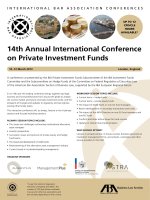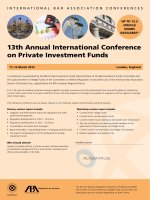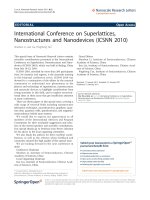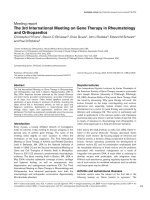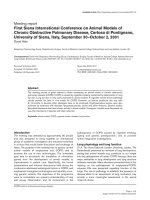BIS 99 3rd international conference on business information systems, poznan, poland 14 16 april 1999
Bạn đang xem bản rút gọn của tài liệu. Xem và tải ngay bản đầy đủ của tài liệu tại đây (19.68 MB, 295 trang )
BIS'99
Springer
London
Berlin
Heidelberg
New York
Barcelona
Hong Kong
Milan
Paris
Santa Clara
Singapore
Tokyo
Witold Abramowicz and Maria E. Orlowska
(Eds)
BIS '99
3rd International Conference on Business
Information Systems, Poznan, Poland,
14-16 April 1999
Springer
Witold Abramowicz. Professor
Department of Computer Science, The Poznan University of Econo mics, Pola nd
Maria E. Orlowska, Osc, Professor
Department of Computer Science and Electrical Engineering, The University of
Queensland, Australia
ISBN 978-1-85233·167·2 Springer·Verlag London Berlin Heidelberg
British Library Cataloguing in Publication Data
BIS'99: 3rd International Conference on Business
Information Systems, Potnan, Poland, 14·16 April 1999
l.lnformation storage and retrieval systems · Business·
CongreMes
I.Abramowia, Witold II.Orlowska, M. E. (Maria E.)
lIl.lnternational Conference on Business Information
Systems (3rd: 1999: Poznan)
025'.06658
ISBN·i3: 978-1-85233·167·2
e--ISBN·13: 978·1-4471-C87S-7
DOl: 10.1007/ 978·1-447W875·7
Library of Congress Cataloging. in. Publication Data
A catalog record for this book is available from the LibraryofCongress
Apart from any fair dealing for th e purposes of research or private study, or criticism or review. as
permined under the Copyright, Designs and Patents Act 1988. this publication may only be reproduced.
stored or transmined, in any form or by any means, with the prior permission in writing of the
publishers, or in the case of reprographic reproduction in accordance with the terms of licences issued
by the Copyright Licensing Agency. Enquiries concerning reproduction outside those terms should be
sent to the publishers.
© Springer.Veriag London Limited 1999
The use of registered names, trademarks etc. in this publication does not imply. even in the absence of a
specific statement, that such names are exempt from the relevant laws and regulations and therefore free
for general use.
The publisher makes no representation, express or implied, with regard 10 the accuracy of the
information contained in Ihis book and cannot accept any legal responsibility or liability for any errors
or omissions that may be made.
Typesetting: Camera ready by contributors
34/3830·543210
Telekomun ikoc io Polsko S.A ., Poland's notional telecom
operator, i s the largest flower in Poland ' s carparate garden .
How
large
exactly?
We ll,
our
cap ito l base
is
over
30%
bigger than the sum of all the other compan ies on the
Polish Stock Exchange. Combined . Our recent privotisotion
attracted
investors
from
Poland
and
overseas
and
was
healthil y oversubscri bed. And our results reflect our ambitions:
a customer bose that 's growing at a rate of 14% a year;
on investment programme that has already yielded lightning
developments in the areas of ISDN, Internet and data
transmissions services. Of course, there's also
the small matter of profits. A large matter,
in our case. In 1996, net profits were 758 .2
million zloty. In 1997, 1350.6 million zloty.
Rosy figures, we think you' ll agree .
T£LEKOMUHII(.>.CJA I'OLSI(.>. LA.
-$
,. The odver1lse m.nt I'\os b..n (JIved by TP SA and appro....d by J Henry
Sch.od .. & Co L,d J HenlY Sch.od .. & Co L,d " ,.gulo.od by ,he Sf...
and IS tn. Global Coordlr\Otor o ~ 800ktunner ," th. I"Ihol publ" off. rlng
of
SA ', ordinary thor.. and GOR,-
'P
Preface
Welcome to BIS'99!
Business Information Systems 99 is an international conference being held for
the third time. BIS'99 aims to discuss the development, implementation,
application and improvement of computer systems for business processes. It is
addressed to the scientific community, people involved in the development of
business computer applications, and to consultants helping to properly
implement computer technology and applications in industry.
Over 50 selected papers will be presented at BIS'99 during the scientific and
practical sessions. The papers deal with a variety of topics related to computer
systems in management, from the point of view of their application (e.g.,
electronic commerce), their business or industrial users (e.g., business process
re-engineering), and technology (e.g., data warehousing). The submitted papers
underwent a rigorous reviewing process, and the resulting program should
provide an outstanding representation of international research in this area.
We believe that BIS'99 will provoke some interesting international discussion
amongst participants, particularly as this meeting includes a number of invited
lectures by international experts in the area. The BIS'99 international Program
Committee was composed of 53 scientists from diverse locations - from the USA
to Australia, from countries with a stable economy through to those undergoing
economic transformation. This aspect further helps to enrich the conference
program.
BIS'99 will be held on the premises of the Poznan International Fair during
INFOSYSTEM - the most important trade fair of all the electronics,
telecommunications and computer engineering events organized in Poland. This
is another excellent opportunity for BIS'99 participants to observe the current
market on offer of computer hardware and software.
We wish to express our gratitude to all those individuals and institutions who
made this conference possible: to the authors of papers for their contributions, to
the Program Committee members and the additional referees for carefully
reviewing the submissions, to the keynote and invited speakers for kindly
VIII
accepting our invitation, and to all the members of the Organizing Committee,
with special thanks to Danuta Nowacka, Mahmoud Fagir, Pawel Jan Kalczynski,
Krzysztof Wecel and Przemyslaw Grzeszczak from The Poznan University of
Economics, Poland and who has proved to be the "heart and soul" in the local
organization of BIS'99.
Additional thanks are due to Kathleen Williamson of The University of
Queensland who has provided valuable help in the preparation of the
proceedings, and Rebecca Moore at Springer Verlag for her help and advice.
Finally, but very importantly, our gratitude goes to the Sponsors for their
involvement and valuable support, specially for Telekomunikacja Polska S.A.
We thank everyone involved for the work they have put in to bring together such
an interesting program, and we look forward to sharing this with all participants.
We look forward to welcoming you to Poznan in April.
Wit old Abramowicz and Maria E Orlowska
Program Committee Co-Chairs, BIS'99
Table of Contents
Inauguration Session
Building a Case for Consonance
Gary Klein, James J. Jiang, Michael Boyd...................................................................................
3
The Impact of Time Pressure on Idea Generation
Robert M. Myers, Jay E. Aronson, Robert B. Wharton ............................................................. 13
A Discussion on Process Losses in GSS: Suggested Ground Rules for
the Electronic Environment
Wm. Benjamin Martz, Jr. .............................................................................................................. 24
Suggestions for Improving the Diffusion of GroupSystems in Organizations
Morgan M. Shepherd...................................................................................................................... 35
Facilitating and Coordinating Distributed Joint Applications Development
James Suleiman, Roberto Evaristo, Gigi G. Ke/ly ...................................................................... 45
Knowledge Management
Information Systems in Customer-Oriented, Dynamic Environments: The
Marketplace as a Metaphor
Peter C. Lockemann' ....................................................................................................................... 55
Knowledge Management: Life Cycle and Implementation Techniques
August- Wilhelm Scheer, Ursula Markus .................................................................................... 76
Utilising Knowledge Resources: An Activity Perspective of Knowledge
Management
Henry Linger ................................................................................................................................... 86
The Strategic Role of Marketing Information Systems in Modern Business
Jacek Unold ...................................................................................................................................... 103
Internet
Software Engineering on the Web
Joseph E. Urban ............................................................................................................................... 113
Data Warehousing
Data Warehousing Beyond Tools and Data: Justification, Organization, and
Structured Development of Data Warehousing Applications
Robert Winter ................................................................................................................................. 125
x
To the Stars through Dimensions and Facts
jaroslav Pokorny............................................................................................................................. 135
Generating Sample Data for Mining and Warehousing
josef Schiefer, A Min Tjoa ............................................................................................................. 148
Data Mining and Knowledge Discovery in Business: Past, Present,
and Future
Zdzislaw S. Hippe ........................................................................................................................... 158
From Economical Theory to Management Systems
On the Difficulties of Cost/Benefit Analysis: What Management
is Buying when Buying Information Technology Systems
Kenneth Wong, Wita Wojtkowski ............................................................................................... 173
User Preferences in Evaluating Usability of Software Product: A Multicriteria
Approach
Marcin Sikorski ............................................................................................................................... 182
Business Process Re-engineering
Re-engineering: Problems with Theory and Practical Application
jerzy Kisielnicki .............................................................................................................................. 191
Flexible Business Process Models and their Application
Christian Mittasch .......................................................................................................................... 203
Business Processes Based Information Systems Development
Vaclav Repa ..................................................................................................................................... 216
Database in SupPort of BIS
Towards Exploitation of the Data Universe - Database Technology for
Comprehensive Query Services
Klaus R. Dittrich, Ruxandra Domenig........................................................................................ 231
Prototype Validation of the Rectangular Attribute Cardinality Map for Query
Optimization in Database Systems
Murali Thiyagarajah, B. john Oommen .................................................................................... 250
Workflow Management Issues
Time Management in Workflow Systems
johann Eder, Euthimios Panagos, Heinz Pozewaunig, Michael Rabinovich ....................... 265
On Capturing Process Requirements of Workflow Based Business
Information Systems
Wasim Sadiq, Maria E. Orlowska ................................................................................................ 281
Author Index .............................................................................................................. 295
List of Authors
Aronson Jay E.
Department of Management
Terry College of Business
The University of Georgia Brooks Hall
Athens, USA
e-mail:
Boyd Michael
School of Business
The University of Texas of the Permian Basin
Odessa, USA
e-mail:
Dittrich Klaus R.
Department of Information Technology
University of Zurich
Zurich, Germany
e-mail:
Domenig Ruxandra
Department of Information Technology
University of Zurich
Zurich, Germany
e-mail:
Eder Johann
AT&T Labs - Research
Florham Park, USA
e-mail:
Evaristo Roberto
College of Business Information Technology
and Electronic Commerce
Department University of Denver
Denver, USA
e-mail:
Hippe Zdzislaw S.
Department of Computer Chemistry
University of Technology
Rzeszow, Poland
e-mail:
Jiang James J.
Department of Computer Information Systems
College of Administration and Business
Louisiana Tech University
Ruston, USA
e-mail:
Kelly Gigi G.
School of Business Administration
The College of William & Mary Williamsburg,
USA
e-mail:
Kisielnicki Jerzy
Warsaw University
Faculty of Managemaent
Warsaw, Poland
e-mail:
Klein Gary
College of Business and Administration
The University of Colorado,
Colorado Springs, USA
e-mail:
Linger Henry
School of Information Management & Systems
Monash University
Caulfield East, Victoria, Australia
e-mail:
XII
Lockemann Peter C.
Fakultat fur Infonnatik,
Universitat Karlsruhe and Forschungszentrum Infonnatik
an der Universitat Karlsruhe (FZl)
Karlsruhe, Gennany
e-mail:
Markus Ursula
Institute for Infonnation Systems (IWi)
University of Saarland
Saarbruecken, Gennany
e-mail:
Martz Wm. Benjamin, Jr.
Accounting & MIS
College of Business
California State University, Chico
e-mail:
Mittasch Christian
Institut fur Infonnatik
TU Bergakademie Freiberg
Freiberg, Gennany
e-mail:
Myers Robert M.
Rinker School of Business
Palm Beach Atlantic College
West Palm Beach, USA
e-mail:
Oommen B. John
School of Computer Science
Carleton University
Ottawa, Canada
e-mail:
Orlowska Maria E.
Distributed Systems Technology Centre
Department of Computer Science & Electrical Engineering
The University of Queensland
Australia
email: {wasim.maria}@dstc.edu.au
Panagos Euthimios
AT&T Labs - Research
Florham Park, USA
e-mail:
Pokorny Jaroslav
Department of Software Engineering
Faculty of Mathematics and Physics
Prague, Czech Republic
e-mail:
Pozewaunig Heinz
Department of Infonnatics Systems
University of Klagenfurt, Austria
e-mail:
Rabinovich Michael
AT&T Labs - Research
Florham Park, USA
e-mail:
Repa Vac1av
Prague University of Economics
Praha, Czech Republic
e-mail:
Sadiq Wasim
Distributed Systems Technology Centre
Department of Computer Science & Electrical Engineering
The University of Queensland
Australia
email: {wasim.maria}@dstc.edu.au
XIII
Scheer August-Wilhelm
Institute for Information Systems (IWi)
University of Saarland
Saarbruecken, Germany
e-mail:
Schiefer Josef
Institute of Software Technology (E 188)
Vienna University of Technology
Vienna, Austria
e-mail:
Shepherd Morgan M.
Information Systems University of Colorado
Colorado Springs, USA
e-mail: mailto:
Sikorski Marcin
Technical University of Gdansk,
Faculty of Management and Economics
Gdansk, Poland
e-mail:
Suleiman James
University of Colorado
Colorado Splings College of Business
Department of Information Systems
Colorado Springs, USA
e-mail:
Thiyagarajah Murali
School of Computer Science
Carleton University
Ottawa, Canada
e-mail:
TjoaA Min
Institute of Software Technology (EI88)
Vienna University of Technology
Vienna, Austria
e-mail:
Unold Jacek
Wroclaw University of Economics
Faculty of Management and Computer Science
Wroclaw, Poland
e-mail:
Urban Joseph E.
Arizona State University
Department of Computer Science and Engineering
Tempe, USA
e-mail:
Wharton Robert B.
Rinker School of Business
Palm Beach Atlantic College
West Palm Beach, USA
Winter Robert
Institute of Information Management and
Post-Graduate Program in Business Engineeling
University of St. Gallen
St. Gallen, Switzerland
e-mail:
Wojtkowski Wita
Computer Information Systems
and Production Management
Boise, USA
e-mail:
Wong Kenneth
Technical Support
Cougar Mountain Software
Potomac, USA
e-mail:
Inauguration Session
Building a Case for Consonance
Gary Klein
College of Business and Administration
The University of Colorado, Colorado Springs
Colorado Springs, USA
e-mail:
James J. Jiang
Department of Computer Information Systems
College of Administration and Business
Louisiana Tech University
Ruston, USA
e-mail:
Michael Boyd
School of Business
The University of Texas of the Permian Basin
Odessa, USA
e-mail:
Abstract
A number of theories and practices lean toward the importance of
achieving agreement among various stakeholders and practices in
organizations. Consonance is such a concept applied to systems development and allows likelihood of success to be measured at the
start of a project rather than the conclusion. This paper reviews theory and preliminary studies that support the concept of consonance.
1. Introduction
Attaining system success has been the goal for information system developers
since the invention of the computer. Difficulties arise from various sources including conflicting thoughts of various stakeholders, poor evaluative measures,
lack of essential skills on the project, and insufficient support from management
and users. Measures to determine if a system was implemented successfully exist,
but they are aligned at the end of the development process and do not serve to assure success from the start of the project [7]. Consonance is a concept that incorporates management theory and system measures to move the determination of system success to a point earlier in the life of the system [22]. Such a technique can
serve as a tool in achieving success and may function as a predictor of likely success or failure. Consonance can be incorporated into any development process with
effective measures and communication tools already in existence.
W. Abramowicz et al. (eds.), BIS ’99
© Springer-Verlag London Limited 1999
4
Consonance is based on a number of management theories and practices that are
designed to promote success. Essentially, consonance is a theory backed process to
arrive at agreement on target objectives for information systems. The process of
reaching the agreement and monitoring progress during development is the tool for
achieving success and can be composed of techniques preferred by the organization for achieving agreement among constituents. The term consonance was selected because of its Webster's defmition "harmony or agreement among components".
2. Background of Measures
One starting point in the IS field is to understand perspectives on job performance.
Early studies of user satisfaction focused on a particular software product and the
importance of user participation in the process. Doll and Torkzadeh [8], using factor analysis, developed a 12-item instrument that measured five components of
user satisfaction: content, accuracy, format, ease of use and timeliness. More recently, Kettinger and Lee [21], introduced a gap measurement instrument looking
at service quality as an important issue in the determination of IS effectiveness at
the organizational level. Productivity and quality measures exist to reflect the view
of developers and managers [32].
Each of these measures focuses on one group's perspective of system evaluation.
But it is widely perceived that users are more concerned with system use characteristics and relationships with IS personnel whereas the IS personnel are interested
in technical aspects and system quality [9, 12]. It is logical that these different
groups of people may assign different weights to the same criterion due to their
perspective on what is, important [15, 23]. Thus, evaluation must consider both user
and IS group perspectives to be complete [1]. In total, the various potential sources
for feedback include all stakeholders in an information system development and
implementation [6]. The number of measures and studies demonstrates the multiattribute nature ofIS success measurement [7].
Just because we have a plethora of measures, does not mean we have the ability
to apply them in a productive fashion. But the popularity of project orientations for
system design allows the insertion of techniques at various stages of development,
particularly early in the process. Each party entering into a system development
project starts with a set of expectations and knowledge. Often these expectations
will differ from one party to the next. IS developers will want to work on current
technology and efficient software. Users will want a dependable system that functions as promised and fits into their existing workflow procedures with little or no
disruption. Owners will want a cost effective system that will improve the operations of the organization or serve to reach a broader market. The gaps between the
stakeholders on a set of criteria represent a lack of consonance.
The total gap may be over many dimensions. Each party has a set of needs to be
satisfied and initially approach the project with a bias along the lines of those
needs. These are gaps in expectations. In addition, a perception gap could be pres-
5
ent [22]. A perception gap exists when one party has a false impression of the desires of another party. This perception gap can lead the service providers to falsely
target the desires of the clients. Both of these gaps need to be closed in order to
achieve consonance. The agreed upon set of objectives and measures represents
a contract entering into system development activities.
3. Theory Background
The primary theoretical basis for consonance is congruence theory. Congruency
contains five concepts as described by Nightingale and Toulouse [28]. These
concepts are organizational structure organizational values, interpersonal and
intergroup values, and reactions and adjustments of individual organization
members. These four concepts are all moderated by the organization's environment along with the constraints and restrictions that effect that environment.
These concepts create an atmosphere among the members and groups of an organization that are congruent - working toward the overall goals of the organization - even when forced through rules and regulations that are not necessarily
congruent with each members value system. Therefore, according to Nightingale
and Toulouse, congruence is a natural state of affairs. How, then, does an organization become incongruent? The obvious answers are change in leadership, environmental changes, shift in cultural values, technology, change in economic conditions, and mergers and acquisitions. The most relevant of these causes for
organizations to become incongruent as pertains to the present time and this
study are the influence of technology and a shift in cultural values over the past
decade.
Milliman, Von Glinow, and Nathan [27] approach the problem of "fit" among
organizational subcomponents affect the congruence of an organizations human
resource population. Their main focus is on human resource management (HRM),
which also ties into the consonance concept. They address several issues in the
application of congruence theory to HRM. First, the concept of fit needs to be
clarified in relation to HRM, it is the degree to which the needs, demands, goals,
objectives, and structure of one component meld with other organizational components. This in tum increases overall effectiveness of the organization. Second, what
is flexibility and what is the relationship to fit? Milliman et al define flexibility as
the capacity of the HRM to adapt effectively and timely to the environmental
changes and internal organization changes. Four main categories that would require
flexibility are 1) a dynamic environment (changing technology), 2) a variety of
different environmental conditions and situations (value changes and technology),
3) Rapidly changing organizational goals and strategies, 4) two or more divergent
organizational goals. The final issue is what conditions will fit and/or flexibility
lead to organizational effectiveness. Literature looks at the key to strategic management as being able to cope with change (flexibility) and continual adaptation to
achieve fit between an organization's internal and external environments. All of
these are issues in which consonance is an essential part.
6
Vancouver and Schmitt [30] explore organizational goal congruence. Theyapproach it by using a constituency concept. They look at relationships between supervisor and subordinate and between worker and constituents. They have operationalized these comparisons by using job satisfaction, organizational commitment,
and intention to quit. By using this person-organization fit concept, it allows one to
measure congruence using the idea that organizational goals reflect the values and
commitments of the founders and leaders of organizations and the people who
make up the organization. It can be compared to group cohesiveness - goal match
between member and constituency. This match is necessary for effectiveness and
efficiency and relates to consonance between end user and IS personnel.
Edwards [10] gives a very in-depth explanation of the problems that have arisen
in the organizational behavior research of congruence. The methods used to operationalize and measure the constructs have been flawed in the origins and caused
many problems with the relevancy of the results. Edwards has offered an alternative that will do away with some of the problems. All data should be viewed in
three dimension using pairs to process the data. The outcomes should be viewed as
three dimensional and constraints should not be imposed but proven as hypothesis
that are confirmed.
Two more research papers that deal with congruence also bring out interesting
points that can be applied to this research. Brown, Cron, and Slocum [5] deal with
trait competitiveness in competition. They test the compatibility of individual traits
for competitiveness with the competitive organizational traits and realize there is
a delicate balance that must be maintained to prevent counter productivity. If the
competition and is in proper balance it produces goal setting and higher performance. Bozarth and Berry [4] measure congruence in a manufacturing/marketing
environment. The interesting points about strategic fit also give credence to the
concept of consonan<:e in this research paper. Bourgeois [3] produced research on
the importance of means over goals which also fits into the ideals being expounded
upon in these first two documents. He is able to point out that the pursuance of
means yields higher productivity than the simple establishment of goals. Setting
congruent goals is an important step, however, the establishment of means to pursue those goals should also maintain a high priority in our endeavor to find congruence or consonance.
Following the previous lines of conviction on congruence, incongruence, and
goal setting the issue of agency theory can also be established as an anchor to the
consonance concept. Agency theory deals with the relationship of the agent to the
principal. The agent should always act in the interest of the principal. Setting the IS
professional as the agent and the end user as the principal, the agent should be
working in the best interests of the principal. The goals of the principal and the
goals of the agent are based on their own self interests and rarely are they perfectly
aligned. This misalignment is caused by goal incongruence and information asymmetries [14]. These problems result in lower effectiveness and efficiency. Consonance will be a procedure that can help detect these problems.
Eisenhardt [11] did an in depth study on agency theory and how it could be used
in the organizational theory literature. She considers and answers four questions
7
that deal with what is agency theory, how does it contribute to organizational theory, is it empirically valid, and in what areas does it relate to organizational theory.
She reiterates that agency theory deals with goal incongruence and the difficulty of
monitoring the agent. She also pointed out the two schools of thought about agency
theory. The positivists believing more in contractual control and the principalagent side looking at a lower level that can be tracked and mathematically tested.
Eisenhardt points out the benefits and constraints of each school and how each can
be applied to the organization and the results are shown to be costly if the goals are
incongruent. Gurbaxani and Whang [13] approach agency theory specifically as
related to information technology and reconfirm the probability of goal incongruity
and the resulting costs. Lastly in tying agency theory to the concept of consonance,
Keil [19] wrote about escalation of information systems that were in trouble economically. He used some of the same bases previously stated in this review. Lack
of goal congruency - or consonance -leads to information asymmetry. The asymmetry most often narrows down to the resistance of management (agent) to report
unforeseen problems to the end user (principal) that ultimately drives all costs of
the project up. Many times one of these costs is user dissatisfaction, which ultimately may translate to project failure.
4. Example Cases
The evidence for the presence of a number of gaps comes from a variety of studies
reported in the literature. Project selection criteria vary by strategic orientation of
the system so a careful match of the system and organizational missions are critical
to achieving consonance [18]. Users vary their own criteria depending on a typology of systems, making user involvement in the setting of goals imperative in understanding their desires [16]. Differences exist in the importance of IS personnel
performance expectations within the industry [22]. Perceptions of failures also differ by stakeholder, indicating a lack of consonance in prior expectations of the
system [17]. Other potential problems of a consonance lack exist in the area of
system intent to organizational intent, skill requirements of the organization to
hiring and training practices, and a conflict between resources and objectives. The
list includes those items discussed in the earlier section on numerous stakeholders
and components and numerous others described in textbooks and research
throughout the years.
As part of the work to examine the presence of consonance, the authors have
collected data on consonance at the start of a project. One study collected data
from a survey a data processing professionals and their associated users. The questionnaire was a multi-item scale pre- and post- tested for ambiguity and reliability.
The sample was taken from a list of list of 140 businesses identified by a local
Economic Development Center sponsored by a major mid-western university.
Users were approached directly and asked to complete the questionnaire and
identify an associated IS staff member. Users rated IS personnel performance,
perceived importance of the six measures listed in table I, and their perception of
8
the importance placed on each measure by the IS personnel. IS personnel rated
their self perceived job performance, the importance they attach to each of the
ilems, and their perception of the importance placed on each measure by the users.
The participants held a wide variety of managerial positions in industry (the user
group) and had a breadth of experiences in information system development (the
IS personnel group). The collected data allow us to examine existing gaps in the
IS profession.
Table 1. Comparison of User and IS Personnel Views
User's
Impor~
IS Personnel's
Importance
Importance
ranee Ratings
vs.
Satisfaction:
Ratings:
IS Personnel's
Estimate of
Users vs.
IS personnel
Users vs.
Estimate of
IS Personnel
IS personnel
User Views
Views
I
2
J
4
Quality of work
perfonned
D
D
D
NS
Project
management tasks
D
D
NS
D
Analytical tasks
D
NS
NS
NS
Interpersonal skills
D
D
NS
NS
Dependability
D
D
NS
D
Teamwork
& Leadership
D
D
D
NS
Performance
Ratings
vs. User
D = significant differences at .05 leve l or below
Table I contains a sununary for each criterion and where there are significant
differences between the users' and IS personnel's perspec tives. If there are significant differences we have problems with consonance where users and IS personnel
are on different "wavelengths". This could lead to persormel and user dissatisfaction as well as poor perfonnance [20] and possibly labor tumover [29]. In a recent
anic\e, London and Smither [23] discuss Multisource feedback which provides the
ratee with more infonnation to interpret and integrate than that provided by supervisors alone. Ashford [2] points out that employees need to develop proficiency in
observing and evaluating their behavior in a manner which is consistent with how
others perceive and evaluate it. As Yanunarino and Atwater [31] found, accurate
self assessments help employees correct errors and tailor their perfonnance.
9
We fmd in column 1, Table 1 that the IS personnel rate satisfaction significantly
higher on each measure for the same overall jobs than the IS users do. This could
be a cause of problems, as McCall and Lombardo [25] point out that inflated self
evaluation was associated with career derailment. McCauley and Lombardo [26]
found that managers whose self evaluations were consistent with co-workers and
customers assessments of them were more likely to be promoted. On the other
hand, in column 2, IS personnel rate all 6 performance criteria as more important
than the IS users do. This could be a good feature as it shows IS personnel to be
demanding on performance criteria for their own work.
Another feature of this study is the comparison of what IS users think IS personnel rate as important and conversely what IS personnel perceive that users see
as important. In these comparisons we see more consonance (Table 1, cols. 3 and 4)
than in the ratings of performance satisfaction and importance of criteria. On the
individual criteria the IS personnel were wrong in their ratings of user views on
only two measures (quality and teamwork and leadership). The user perception of
IS personnel views differed only on project management tasks and dependability.
These shortcomings show a need for more communication and more attention to
the separate measures to achieve increased overall satisfaction.
In a case study involving the information services within a university, differences
were found to exist in expectations of the system performance. The same six measures described were used in a study involving the IS department of a regional university and two groups of users, the staff and the students/faculty. The users were
divided into two groups because of major differences in the applications supported
by the IS department. Again, the importance of each of the items was solicited.
In addition, an overall satisfaction measure from the user groups of the performance of the department and the end-user satisfaction scale of Doll and Torkzadeh was
applied.
4,75T---------------------------------------------------~
4,25
..I.-.-~~--="I--
3,75..1.-.-~~~
I -+- Faculty/Studl
~~~.~~~~~~~~~~~: ~S~ff
I
~IS
3,5 .l-----.---=--..----""""T------,..-~::::::::;:::::::::::::::::::::J
Figure 1: Gaps in Measures of Academic Case
10
Figure 1 shows a graph of the differences in importance of the criteria. The IS department shows a wide gap from both groups of users for three of the six metrics,
smaller differences for two, and little or no difference to the last one. All differences
test significant at the .05 level using t-tests except for the difference between faculty/student and staff users on general tasks and teamwork, and on all three groups
for dependability. As can be seen, the gap is larger from IS department to faculty
student than to staff users on all but the project work category. That is, the area between the staff and IS lines is less than the area between the IS and faculty/student
lines. In this single case example, the overall satisfaction measure and user satisfaction measure test significantly less for the faulty/student group than for the staff
group. This is an early indication ofless consonance leading to lower satisfaction.
5. Summary
The purpose of consonance is to present a theory backed process incorporated into
system planning and development that helps secure system success. Basically, consonance prescribes that various stakeholders must come to agreement on aspects of
the development previously left to system developers. At the start of the project,
users and developers must agree on the importance of certain deliverable characteristics. The underlying IT infrastructure must conform to the strategic orientation
of the firm. IS Goals must be developed consistent with organizational goals. The
more agreement there is among technology, external agencies, management, users,
and IS people; the greater the alignment of the system to the mission of the organization; the greater the consonance of the system.
Much work will still need to be done is formalizing consonance. Numerous metrics will have to be developed to measure system properties that are deemed critical by the development teams within organizations. Studies should be performed to
determine the more critical components of those we discussed and identify possible
new areas of concern. Consonance concepts will have to be fully integrated into the
project life cycle for each adopting organization. Early indications are that consonance holds. Consonance is consistent with published studies and blends well with
existing theory. Subsequent testing must now determine if applying consonance
theory does contribute to the success of an information system.
References
I. Adelman L., Evaluating Decision Support and Expert Systems, John Wiley & Sons,
New York, NY, 1991
2. Ashford S.l Self-Assessments in Organizations: A Literature Review and Integrative
Model. In: Cummings L.L., Stow B.M. (eds) Research in Organizational Behavior.
Vol. 11,1989, pp.133-174, JAI Press, Greenwich, Conn
3. Bourgeois L.l Performance and consensus. Strategic Management Journal, 1980, Vol. I,
pp.227-248
11
4. Bozarth C.c., Beny W.L. Measuring the congruence between market requirements and
manufacturing: a methodology and illustration. Decision Sciences, 1997, Vol. 28, No. I,
pp.121-150
5. Brown S., Cron W.L., Slocum 1. Jr. Effects of Trait Competitiveness and Perceived Interorganizational Competition on Salesperson Goal Setting and Performance. Forthcoming in the Journal of Marketing, 1998
6. Church A.H., Bracken D.W. Advancing the State of The Art of 360-Degree Feedback.
Group & Organization Management, Vol. 22, No.2, June 1997, pp. 149--161
7. DeLone W.H., McLean E.R., Information Systems Success: The Quest for The Dependent Variable. Information Systems Research, 1992, Vol. 3, No.1" pp. 60-94
8. Doll Wm.1., Torkzadeh G., Measurement of End-Use Computing Satisfaction. MIS
Quarterly, Vol. 12, June 1988, pp. 258-274
9. Dos Santos B.L., Hawk S.R. Differences in Analyst's Attitudes Towards Information
Systems Development: Evidence and Implications. Information & Management, 1988,
Vol. 14, pp. 31-41
10. Edwards 1.R. The study of congruence in organizational behavior research: critique and
a proposed alternative, Organizational Behavior and Human Decision Processes, 1994,
Vol. 58, pp. 51-100
II. Eisenhardt K.M. Agency theory: an assessment and review, Academy of Management
Review, 1989, Vol. 14, No. 1,57-74
12. GrafD., Misic M. The Changing Roles of the Systems Analysts. Information Resources
Management Journal, Spring 1994, Vol. 7, No.2, pp. 15-23
13. Gurbaxani V., Whang S. The impact of information systems on organizations and markets, Communications of the ACM, 1991, Vol. 34, No.1, pp. 59--73
14. Huarng A.S., System development effectiveness: an agency theory perspective, Information and Management, 1995, Vol. 28, pp. 283--291
15. Ives 8., Olson M. User Involvement and MIS Success: A Review of Research. Management Science, Vol. 30, No.5, 1982, pp. 19--29
16. Jiang 1., Klein G. User Perceptions of Evaluation Criteria for Three System Types. Data
Base for Advances in Information Systems, Summer 1996, pp. 63-69
17. Jiang 1., Klein G., Balloun 1. Perceptions of System Development Failures. Infonnation and
Software Technology, Vol. 39, No. 14-15, February 1998, pp. 933--937
18. Jiang J., Klein G. Infonnation System Project Selection Criteria Variations Within Strategic
Classes. To appear in IEEE Transactions on Engineering Management, 1999
19. Keil M., Escalation of commitment in information systems development: a comparison
of three theories. Academy of Management Journal, 1996, pp. 348-352
20. Kerr J., Bettis R.A. Boards of Directors, Top Management, Compensation and Shareholder Return. Academy of Management Journal, 1987, Vol. 30, pp. 645-664
21. Kettinger WmJ., Lee Choong C. Perceived Service Quality and User Satisfaction with
the Information Services Function. Decision Sciences, Sept.-Dec. 1994, Vol. 25, No. 5/6
22. Klein G., Jiang J., Sobol M. A New View of IS Personnel Performance Evaluation. To appear in Communications of the ACM
23. London M., Smither J.W. Can Multi-Source Feedback Change Perceptions of Goal Accomplishment, Self-Evaluation and Performance-Related Outcomes? Theory-Based Applications and Directions for Research. Personal Psychology, Winter 1995, Vol. 48,
No.4, pp. 803--839
24. London M., Self and Interpersonal Insight: How People Learn About Themselves and
Others in Organizations, New York, Oxford University Press, 1995
12
25. McCall M.W., Lombardo M.M. Off The Track: Why and How Successful Executives
Get Derailed. 1983 (Tech Rept. #21). Greensboro, N.C.: Center for Creative Leadership
26. McCauley c., Lombardo M.M. Benchmarks: An Instrument for Diagnosing Managerial
Strengths and Weaknesses. In: Clark K.E., Clark M.B. (eds.) Measures of Leadership,
1990, pp. 535-545. West Orange, NJ: Leadership Library of America
27. Milliman J., Von Glingow M.A., Nathan M. Organizational life cycles and strategic international human resource management in multinational companies: implications for congruence theory. Academy of Management Review, 1991, Vol. 16, No.1, pp. 318-339
28. Nightingale D.V., Toulouse 1 Toward a multilevel congruence theory of organization.
Administrative Science Quarterly, 1977, Vol. 22, pp. 264-280
29. Sherman D. The Relationship between Factors in the Work Environment and Turnover
Propensities Among Engineering and Technical Support Personnel. IEEE Transactions
on Engineering Management, May 1986, Vol. EM-33, No.2, pp. 72-78
30. Vancouver lB., Schmitt N.W. An exploratory examination of person-organization fit:
organizational goal congruence. Personnel Psychology, 1991, Vol. 44, pp. 333-352
31. Yammarino F.l, Atwater L.E. Understanding Self-Perception Accuracy: Implications
for Human Resources Management. Human Resources Management, 1993, Vol. 32,
pp.231-247
32. Zahedi F. Quality Information Systems. 1995, Danvers, MA: Boyd & Fraser
The Impact of Time Pressure
on Idea Generation
Robert M. Myers
Rinker School of Business
Palm Beach Atlantic College
West Palm Beach, USA
e-mail:
Jay E. Aronson*
Department of Management
Terry College of Business
The University of Georgia
Brooks Hall
Athens, USA
e-mail:
Robert B. Wharton
Rinker School of Business
Palm Beach Atlantic College
West Palm Beach, USA
Abstract
The issues of time pressure and idea generation are vital concerns for
businesses today. In this paper, we examine the impact of time pressure on idea generation and creativity. One hundred and two business students were used to examine the impact of time pressure on:
(a) the rate of ideas generated, and (b) the rate of the creativity of the
generated ideas.
Results of the study supported the research hypotheses that the
mean rate of: (a) idea generation, and (b) the creativity of the ideas is
unequal in groups operating under differing time pressure conditions.
1. Introduction
Many organizations have a desire to improve the methods used in group decision
making activities. As a result, there has been much research to identify methods
that would produce more efficient and effective group decision making. Much of
the early work did not involve the use of technology but made use of other techniques often centering around the concept of brainstorming. This brainstorming
* Corresponding Author
W. Abramowicz et al. (eds.), BIS ’99
© Springer-Verlag London Limited 1999
14
theory was supplied by Osborn [14] as a method of group problem solving to increase the quality and quantity of ideas developed by group members. In today's
fast-paced business environment, time pressure is a major factor in conducting
business. Research, however, indicates that few studies have investigated this issue
as it relates to group processes, productivity, and creativity [11].
Some time pressure studies have found that group decisions made under time
pressure have lead to poor performance for a variety of groups including government committees [7], various businesses [16], and even juries [5]. Providing too
much time for group decisions may even lead to boredom and dissatisfaction [8].
Therefore, the selection of the proper time frame for groups to complete tasks successfully is critical.
2. Theory and Research
Concepts associated with brainstorming have been widely investigated since Osborn [14] first proposed the theory. Over twenty studies have found that nominal
groups (individuals generating ideas on their own, which are then combined with
the ideas of other individuals also working on their own) generate more ideas than
the same number of people in face-to-face interacting groups [3, 13].
Only a few studies have examined the impact of time constraints on group productivity. The studies that have investigated time constraints and group productivity
have used a variety of approaches. Wright [18] found that group members under
time pressure would systematically place greater weight on negative evidence than
those group members not under time pressure. Zakay and Wooler [19] found that
high effectiveness diminished rapidly when time pressure was applied. They reported that under time pressure, old habits are activated. These old habits tend to
overrule newly learned skills.
The concept of entrainment as it relates to group performance is a relatively new
area of research. The entrainment concept when applied to group performance was
initially investigated by Kelly and McGrath [11]. Their definition of social entrainment is "a concept that refers to the altering of social rhythms or patterns by external
conditions (such as time limits), and to the persistence of such new rhythms over
time" [11, p. 395].
Kelly et al. [9] investigated the concepts of capacity and capability as they relate to time pressure and group decision making. Capacity problems generally
involve issues of either time, load, or difficulty level. This study found that if
a group is facing capacity problems associated with time pressure, the members
will attempt to compensate for the capacity problem by speeding up their work
rate. The concept of entrainment is observed when the group continues this pace in
a subsequent trial even when the time limit has been relaxed [9]. Kelly et al. [9]
noted that groups operating under classic brainstorming instruction would most
likely experience capacity problems as they attempt to generate as many ideas as
possible.
